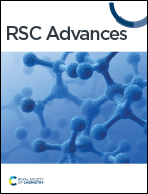Delocalization quantitatively mapped for prototypic organic nitroanions as well as azidoform anions†
Abstract
Delocalization of occupied orbitals impacts the chemical bonding in the simplest known pernitroanions [(NO2)3C]− (1) and [(NO2)2N]− (2) as well as other functionalized organic anions. By quantitatively mapping it onto molecular backbones of 1, 2, [CH2NO2]− (3), [CH3NNO2]− (4) and [C(N3)]− (6) anions (all modeled by QM calculations), the Weinhold's NBO analysis refines their chemical structure, enabling to explain and even predict their essential chemical behaviour. In detail, the HOMO of 1 and 2 is associated with the central atom to the degree of 70.7% and 80.4%, respectively, while the HOMO localization on O atoms for 3 and 4 is 85.3% and 81.1%, respectively. Predomination of C-alkylation for 1 and that of O-alkylation for 3 in non-coordinating solvents thus becomes clear. The important news is that the easiness of homolytically disrupting the N–N bond in 2, a constituent of inexpensive powerful explosives, is because of the occupancy of the related σ*orbital increases with stretching this bond. The same is true for electrocyclic extrusion of NO3− from this molecule. This antibonding effect may be assumed to be the common cause of the proneness of aliphatic nitro compounds to decompose. Pyramidal anion 6 is a highly localized carbanion. Its isomer of molecular symmetry CS has a unique chemical structure of its azido substituents: each of them is represented by one high-weight resonance structure, e.g., N–N![[triple bond, length as m-dash]](https://www.rsc.org/images/entities/char_e002.gif) N. The prediction is that the dinitrogen-eliminating decomposition of this isomer is more facile than of the isomer of C3 symmetry. In summary, this study affords three novel particular insights into the chemical structure and reactivity of these anions: chemically telling delocalization-augmented molecular structures, a reasonable hypothesis of the common cause of thermally triggered instability of aliphatic nitro compounds, and discovered one-resonance structure azido groups.
N. The prediction is that the dinitrogen-eliminating decomposition of this isomer is more facile than of the isomer of C3 symmetry. In summary, this study affords three novel particular insights into the chemical structure and reactivity of these anions: chemically telling delocalization-augmented molecular structures, a reasonable hypothesis of the common cause of thermally triggered instability of aliphatic nitro compounds, and discovered one-resonance structure azido groups.



 Please wait while we load your content...
Please wait while we load your content...